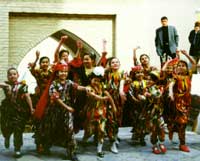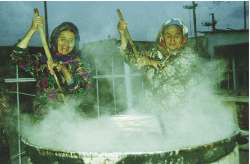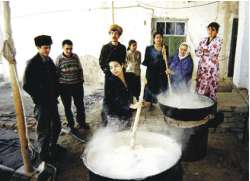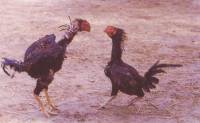 |
 |
Celebrated on March 21st, Navrus is one of Uzbekistan's most colourful and vibrant festivals. The festival takes place outdoors with impressive performances of traditional music and dancing as well as numerous street parties and spirited displays of cock fighting and ram-butting. Navrus means 'new day' in Persian and commemorates the beginning of the new year. Its roots stem from Zoroastrian times when it was a celebration of the end of a gruelling winter and the heralding of spring. Traditionally the festival lasted for six days and was a time when all prisoners were set free and when seven meals were served daily with food beginning with the letter 's'. People used to get up early and eat three spoons of honey and three pieces of honeycomb in the belief that this would ensure protection against illness during the coming year.
 'Winter garden with vines and pomegranite trees buried' |
 'After Navrus the vines and fruit trees are unearthed and the garden comes to life' |
Today Navrus is still hailed as the coming of spring and rebirth when
vines, fig and pomegranate trees which were buried during winter to protect
them from frost are unearthed. Summer clothes are also worn for the first
time and watery ice-cream is sold everywhere.
Interestingly, the observance of Navrus was prohibited during the early
stages of both Islamic and Soviet rule although people continued to celebrate
it unofficially. Since independence in 1990 Navrus has become a major
public holiday and is a day for donning your best clothes, visiting relatives
and strolling through the streets to view the festivities.
In Khiva the Ichan Kala is packed with Soviet-style display stalls set up by the town's schools, businesses and farms, each with tables laden with the produce of factories and collective farms, whilst teachers and employees sit and take in the scene. There's a real carnival atmosphere among the crowded streets with musicians attired in bright, traditional garb, performances of children singing and dancing, shashlik (kebab) vendors vying for business and photographers persuading passersby to dress up as khans and harem girls and pose for a picture. Near the Ichan Kala, the street next to the park is closed to traffic and provides a great opportunity to wander around enjoying an ice-cream or to view the amazing panorama of the Old City from the big wheel. |
 'Traditional crafts on display' |
|
|
The Ichan Kala festivities usually finish around lunchtime and are sometimes followed by various displays in the nearby stadium. An excited audience gathers to watch cock fighting, ram-butting and, at times, horse racing. Khorezm has always been famous for its wrestling and Navrus provides an ideal opportunity for local wrestlers to demonstrate their prowess in what is known as 'kuresh'. There are often puppet shows in the afternoon and evening at the puppet theatre near the Blue Dome Restaurant. These include life size puppets and need no linguistic understanding to be thoroughly entertaining. |
 'Locals trying their hand at kuresh' |
||
|
|||
 'Grannies stirring sumalak' |
However by far the highlight of Navrus is the making of sumalak - a brown, caramel-like paste which takes up to 16 hours to cook! It is a symbol of new life and is made from the first shoots of wheat that begin poking through the soil in March. Neighbours and colleagues gather together to prepare this, stirring the giant cauldrons of sumalak into the night and through to the morning, singing and gossiping and enjoying a party atmosphere!
 'Washing the minced wheat shoots' |
The first step is the mincing of wheat shoots (complete with seeds) and the resulting mush is washed by women in water, which quickly becomes white and milky. This process is repeated three times and the white water is then mixed with flour and poured into a huge cauldron that the men have scraped and cleaned.
The mixture is then simmered over a fire for the next 14 to 16 hours with everyone taking a turn at the stirring in between the jokes and singing. During this stirring, the starch from the flour becomes sweet and lends a rich malty flavour to the sumalak. The end product is a wonderfully thick paste with a high nutritional value although to the uninitiated it can be something of an acquired taste! Look out for it on sale at the bazaars throughout March.
 |
 'Only 16 hours to go!' |
| Tour Links: | |
| 'Garden' | |
| 'Ferris Wheel' | |
| Guidebook Links: | |
| 'Other festivals' | |
| 'Sports festivals' | |
| 'Zoroastrianism' | |



